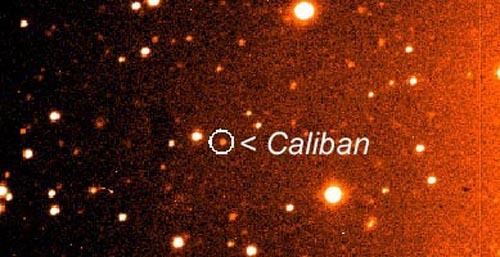Discovery date September 6, 1997 Mean orbit radius 7,231,000 km Average orbital speed 0.91 km/s Orbital period 580 days Discovery site Palomar Observatory | Adjectives Calibanian Eccentricity 0.1812 Discovered 6 September 1997 | |
 | ||
Discovered by Philip D. NicholsonBrett J. GladmanJoseph A. BurnsJohn J. Kavelaarsusing the Hale telescope Similar Brett J Gladman discoveries, Uranus moons, Other celestial objects | ||
Caliban (/ˈkælᵻbæn/ KAL-i-ban or /ˈkælᵻbən/ KAL-ə-bən) is the second-largest retrograde irregular satellite of Uranus. It was discovered on 6 September 1997 by Brett J. Gladman, Philip D. Nicholson, Joseph A. Burns, and John J. Kavelaars using the 200-inch Hale telescope together with Sycorax and given the temporary designation S/1997 U 1.
Contents
Designated Uranus XVI, it was named after the monster character in William Shakespeare's play The Tempest.
Orbit
Caliban follows a distant orbit, more than 10 times further from Uranus than the furthest regular moon Oberon. Its orbit is retrograde, moderately inclined and slightly eccentric. The orbital parameters suggest that it may belong to the same dynamic cluster as Stephano and Francisco, suggesting common origin.
The diagram illustrates the orbital parameters of the retrograde irregular satellites of Uranus (in polar co-ordinates) with the eccentricity of the orbits represented by the segments extending from the pericentre to the apocentre.
Physical characteristics
Its diameter is estimated at 72 km (assuming albedo of 0.04) making it the second largest irregular satellite of Uranus, half the size of Sycorax, the biggest irregular satellite of Uranus.
Somewhat inconsistent reports put Caliban in light-red category (B–V = 0.83 V–R = 0.52, B–V = 0.84 ± 0.03 V–R = 0.57 ± 0.03), redder than Himalia but still less red than most Kuiper belt objects. Caliban may be slightly redder than Sycorax. It also absorbs light at 0.7 μm, and one group of astronomers think this may be a result of liquid water that modified the surface.
The light curve suggests the rotation period of Caliban is about 2.7h.
Origin
Caliban is hypothesized to be a captured object: it did not form in the accretionary disk that existed around Uranus just after its formation. The exact capture mechanism is not known, but capturing a moon requires the dissipation of energy. The possible capture processes include: gas drag in the protoplanetary disk, many body interactions and the capture during the fast growth of the Uranus' mass (so-called "pull-down").
